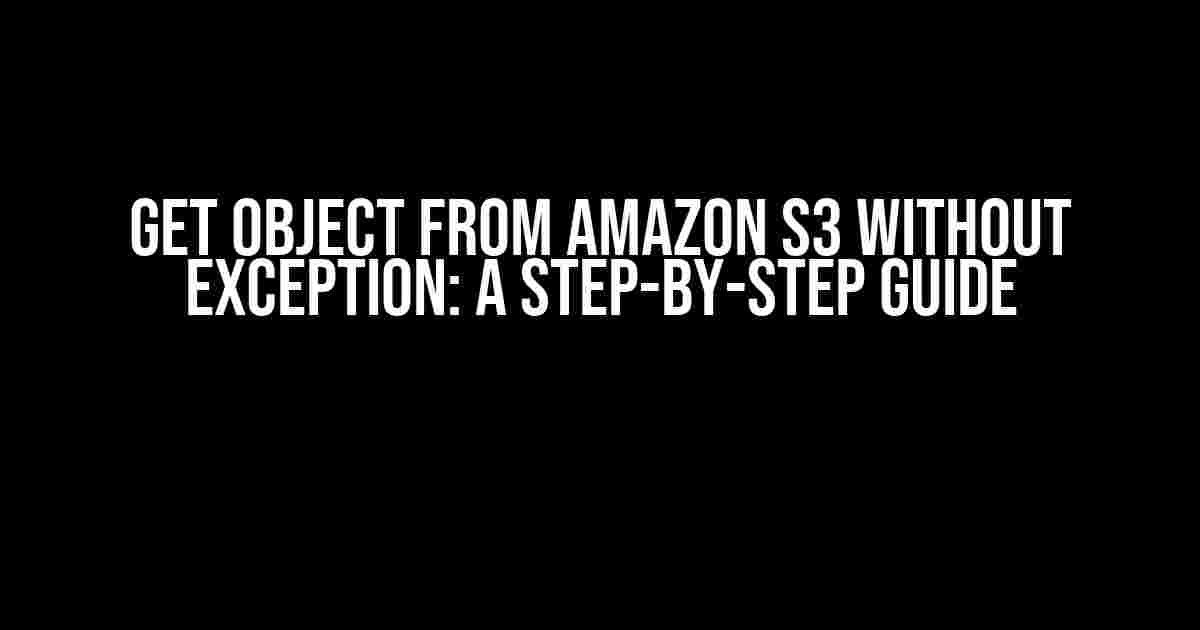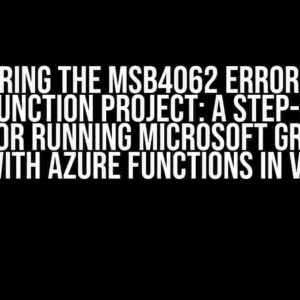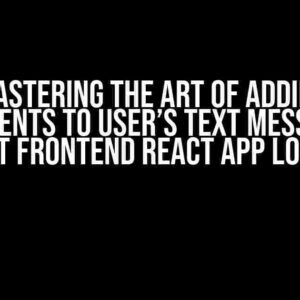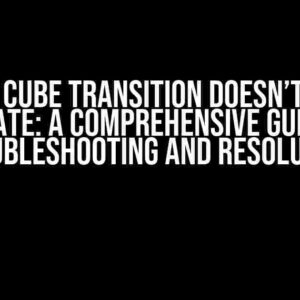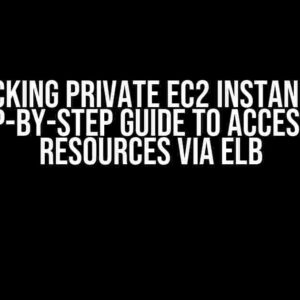If you’re working with Amazon S3, you know that getting objects from the bucket can be a bit tricky. Sometimes, you may encounter exceptions that prevent you from accessing the objects you need. But fear not! In this article, we’ll show you how to get objects from Amazon S3 without exceptions, so you can focus on your project without any hiccups.
Understanding the Problem
Before we dive into the solution, let’s understand the problem. When you try to get an object from Amazon S3, you may encounter exceptions like:
- AmazonS3Exception
- AmazonServiceException
These exceptions can occur due to various reasons, such as:
- Invalid bucket or object name
- Invalid credentials or permissions
- Network connectivity issues
- Bucket or object not found
In this article, we’ll provide you with a step-by-step guide on how to get objects from Amazon S3 without exceptions, so you can avoid these common pitfalls.
Prerequisites
Before we begin, make sure you have the following:
- An Amazon S3 bucket with the necessary permissions
- The Amazon S3 SDK installed in your project
- A valid AWS access key ID and secret access key
Step 1: Set up Your Amazon S3 Client
To get started, you need to set up your Amazon S3 client. You can do this by creating an instance of the AmazonS3Client class and providing your AWS access key ID and secret access key:
import com.amazonaws.services.s3.AmazonS3;
import com.amazonaws.services.s3.AmazonS3ClientBuilder;
AmazonS3 s3Client = AmazonS3ClientBuilder.standard()
.withRegion("your-region")
.withCredentials(new AWSStaticCredentialsProvider(new BasicAWSCredentials("YOUR_ACCESS_KEY_ID", "YOUR_SECRET_ACCESS_KEY")))
.build();
Replace “your-region” with the region where your bucket is located, and “YOUR_ACCESS_KEY_ID” and “YOUR_SECRET_ACCESS_KEY” with your actual AWS access key ID and secret access key.
Step 2: Check if the Bucket Exists
Before you try to get an object from Amazon S3, you need to make sure the bucket exists. You can do this by using the doesBucketExist method:
if (s3Client.doesBucketExist("your-bucket-name")) {
System.out.println("Bucket exists");
} else {
System.out.println("Bucket does not exist");
}
Replace “your-bucket-name” with the name of your Amazon S3 bucket.
Step 3: Check if the Object Exists
Once you’ve verified that the bucket exists, you need to check if the object exists. You can do this by using the doesObjectExist method:
String objectKey = "path/to/your/object";
if (s3Client.doesObjectExist("your-bucket-name", objectKey)) {
System.out.println("Object exists");
} else {
System.out.println("Object does not exist");
}
Replace “path/to/your/object” with the key of the object you want to retrieve.
Step 4: Get the Object from Amazon S3
Now that you’ve verified that the bucket and object exist, you can get the object from Amazon S3 using the getObject method:
S3Object object = s3Client.getObject("your-bucket-name", objectKey);
This will return an S3Object instance, which contains the object’s metadata and data stream.
Step 5: Handle Exceptions
Even with the previous steps, you may still encounter exceptions when getting objects from Amazon S3. To handle these exceptions, you can use a try-catch block:
try {
S3Object object = s3Client.getObject("your-bucket-name", objectKey);
} catch (AmazonS3Exception e) {
System.out.println("AmazonS3Exception: " + e.getMessage());
} catch (AmazonServiceException e) {
System.out.println("AmazonServiceException: " + e.getMessage());
} catch (IOException e) {
System.out.println("IOException: " + e.getMessage());
}
This will catch any AmazonS3Exception, AmazonServiceException, or IOException that may occur when getting the object from Amazon S3.
Best Practices
To avoid exceptions when getting objects from Amazon S3, follow these best practices:
- Use the correct bucket and object names
- Ensure you have the necessary permissions and credentials
- Check for bucket and object existence before getting the object
- Handle exceptions properly using try-catch blocks
| Best Practice | Description |
|---|---|
| Use the correct bucket and object names | Make sure you’re using the correct bucket and object names to avoid errors. |
| Ensure you have the necessary permissions and credentials | Verify that you have the necessary permissions and credentials to access the bucket and object. |
| Check for bucket and object existence | Check if the bucket and object exist before trying to get the object to avoid errors. |
| Handle exceptions properly | Use try-catch blocks to handle exceptions properly and avoid crashes or errors. |
Conclusion
In this article, we’ve shown you how to get objects from Amazon S3 without exceptions. By following the steps and best practices outlined above, you can avoid common pitfalls and ensure that your project runs smoothly. Remember to always check for bucket and object existence, handle exceptions properly, and use the correct bucket and object names to get objects from Amazon S3 successfully.
By following these steps, you’ll be able to get objects from Amazon S3 without exceptions and focus on developing your project without any hiccups. Happy coding!
Frequently Asked Question
Here are some common questions and answers about getting objects from Amazon S3 without exceptions
How do I avoid exceptions when getting objects from Amazon S3?
To avoid exceptions when getting objects from Amazon S3, make sure to handle exceptions properly using try-catch blocks in your code. Additionally, ensure that the object exists in the specified bucket and that you have the necessary permissions to access it.
What is the difference between GET Object and LIST Objects in Amazon S3?
GET Object is used to retrieve a single object from Amazon S3, whereas LIST Objects is used to list multiple objects in a bucket. If you know the exact key of the object you want to retrieve, use GET Object. If you want to retrieve multiple objects or don’t know the exact key, use LIST Objects.
How do I specify the version of an object when retrieving it from Amazon S3?
To specify the version of an object when retrieving it from Amazon S3, you can use the versionId parameter in your GET Object request. This allows you to retrieve a specific version of the object, rather than the latest version.
What is the maximum size of an object that can be retrieved from Amazon S3?
The maximum size of an object that can be retrieved from Amazon S3 is 5 GB. If you need to retrieve larger objects, you can use Amazon S3’s multipart upload and download feature, which allows you to break down large objects into smaller parts and retrieve them separately.
Can I use caching to improve the performance of GET Object requests in Amazon S3?
Yes, you can use caching to improve the performance of GET Object requests in Amazon S3. Amazon S3 provides a caching mechanism called Amazon CloudFront, which can cache frequently accessed objects at edge locations around the world, reducing the latency and improving the performance of GET Object requests.

